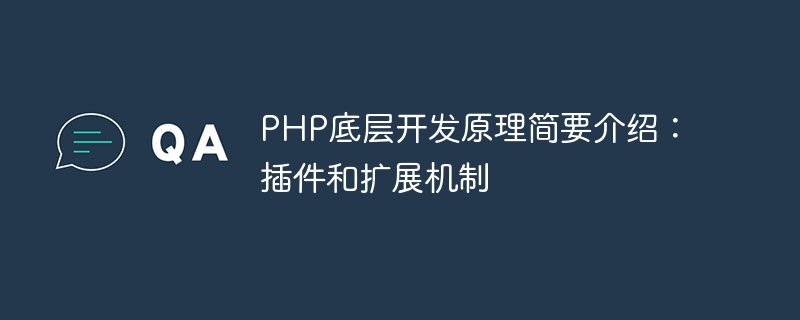Home >Backend Development >PHP Tutorial >A brief introduction to the underlying development principles of PHP: plug-ins and extension mechanisms
A brief introduction to the underlying development principles of PHP: plug-ins and extension mechanisms
- WBOYWBOYWBOYWBOYWBOYWBOYWBOYWBOYWBOYWBOYWBOYWBOYWBOriginal
- 2023-09-09 11:37:531169browse

A brief introduction to the underlying development principles of PHP: plug-ins and extension mechanisms
With the continuous development of the Internet, PHP, as a widely used programming language, has become the focus of many developers People's first choice. However, as developers, do we have a clear understanding of the underlying working principles of PHP? This article will introduce the plug-in and extension mechanism around the underlying development principles of PHP, supplemented by code examples to help readers better understand.
PHP's plug-in mechanism is a mechanism that allows developers to extend the capabilities of PHP by adding additional functionality. Plug-ins often exist in the form of external extensions, which can be written in C and loaded when PHP is run. These plug-ins can provide many powerful functions, such as interacting with databases, generating images, caching data, etc. To understand the principle of the plug-in mechanism, we first need to understand the underlying extension mechanism of PHP.
PHP’s extension mechanism allows developers to use code written in C to extend the core functions of PHP. Through the extension mechanism, developers can directly access the PHP core and write efficient, low-level code to complete certain specific tasks. PHP provides a series of APIs for us to use in extension code. Let's look at a simple example that demonstrates how to write a simple PHP extension:
#include "php.h"
zend_function_entry hello_functions[] = {
PHP_FE(hello_world, NULL)
{NULL, NULL, NULL}
};
zend_module_entry hello_module_entry = {
STANDARD_MODULE_HEADER,
"hello",
hello_functions,
NULL,
NULL,
NULL,
NULL,
NULL,
PHP_MINFO(hello),
PHP_HELLO_VERSION,
STANDARD_MODULE_PROPERTIES
};
#ifdef COMPILE_DL_HELLO
ZEND_GET_MODULE(hello)
#endif
PHP_FUNCTION(hello_world)
{
php_printf("Hello, world!
");
}The above code demonstrates an extension named "hello", which defines a function named "hello_world" . During the extension's initialization phase, we associate this function with the "hello_functions" array so that it can be called from the PHP script. After writing the extension code, we need to compile it into a binary dynamic link library, and then configure it in the PHP configuration file to let PHP load the extension at startup.
Next, let’s take a look at how to use this extension:
<?php hello_world(); ?>
Calling the "hello_world" function in a PHP script will output "Hello, world!". Although this example is very simple, it demonstrates the basic principles of PHP's underlying plug-in and extension mechanism.
Through plug-ins and extension mechanisms, we can add many powerful functions and performance optimizations to PHP. Not only can the core functions of PHP be extended, we can also extend the functions of third-party libraries through the plug-in mechanism. For example, we can write a plug-in that enables PHP to interact with the MongoDB database, or enables PHP to generate high-quality images, etc.
To summarize, this article briefly introduces the plug-in and extension mechanisms in the underlying development of PHP. Through the plug-in and extension mechanism, we can extend the functions of PHP and interact with the PHP core in the form of C code. I hope this article will help readers understand the principles of underlying PHP development and stimulate interest in underlying PHP development.
The above is the detailed content of A brief introduction to the underlying development principles of PHP: plug-ins and extension mechanisms. For more information, please follow other related articles on the PHP Chinese website!

